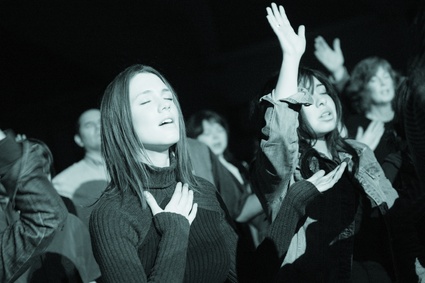 What happens when a Catholic nun experiences God through contemplative prayer? What happens when a Hindu feels the presence of Shiva? What about the religious experiences of Sufis, Jews, Buddhists, and Daoists? The list could go on and on, but a vital question is: how similar or different are these religious experiences? The Institute's Quantifying Religious Experience Project (QRXP) aims to provide an answer using the latest techniques in cognitive psychology and quantitative research.
What happens when a Catholic nun experiences God through contemplative prayer? What happens when a Hindu feels the presence of Shiva? What about the religious experiences of Sufis, Jews, Buddhists, and Daoists? The list could go on and on, but a vital question is: how similar or different are these religious experiences? The Institute's Quantifying Religious Experience Project (QRXP) aims to provide an answer using the latest techniques in cognitive psychology and quantitative research.
The field of scientifically investigating religious experiences currently suffers from imprecision. The instruments scholars use (which primarily consist of narratives) lack the exactness to compare, say, a Catholic nun’s religious experience with a Buddhist’s, or a religious person's existentially intense experience with a non-religious person's existentially intense experience. QRXP addresses this problem by building survey instruments from mid-level neurocognitive structures, such that these structures can be correlated with a religious person’s self-reported subjective experiences. Religious experience would then be quantitatively "profiled" because it would be measured by the intensity of a multidimensional array of specific neurocognitive functions.
Quantifying religious experience in this way has two opposing effects. On the one hand, culturally specific terms (e.g., God, sin, karma) often used in describing religious experiences need to be displaced by terms that make sense at the level of mid-level neurocognitive processes. Further, one goal is to compare the experiences of practitioners from different religious traditions, no one tradition should determine the terminology of religious experience for everyone. On the other hand, no one can reasonably expect cognitive neuropsychology alone to produce all of the data relevant to understanding religious experience. The scientific techniques provide instrumentation and constraints, but the subject’s testimony furnishes priceless qualitative data. In the same way, someone describing what the color red is like is adds something to our understanding of visual perception that goes beyond the mere recording of neurological activity.
QRXP's Enhanced Phenomenology of Consciousness Inventory (EPCI), together with an associated reporting protocol, provides both culturally-independent categories and allows subjects to report their experience. The EPCI provides data about the religious experiencer’s emotion, attention, memory, body sense, cognitive control, and similar mid-level neurocognitive conditions.
More specifically, the EPCI includes items from Ron Pekala's Phenomenology of Consciousness Inventory (PCI) plus a few more. The result is a multidimensional construct of the contents of consciousnessincluding features such as: altered experience, altered awareness (e.g., awake state) physical arousal, (e.g., muscular tightness), attention, imagery (e.g., vivid, dim, normal), internal dialogue, memory (e.g., blurred, hazy, vacant, sharp, distinct, complete), negative affect (e.g., anger, fear, sadness), positive affect (e.g., joy, sexual excitement, love), potency, rationality (i.e., comprehensibility), and self-awareness. To the PCI, the EPCI adds a number of dimensions that have been important in the scientific study of religious experiences: dream state, encountering responsive agent, depth, horizon, scale, complexity, and mystery.
Interestingly enough, piloting suggests that the EPCI distinguishes between the typical religious experiences of (1) men and women (religious experiences are more emotionally negative for females than for males, on the whole, and religious experiences produce greater changes in perceptual experience and physical arousal for females than males), and (2) neurologically healthy and unhealthy people.
Of course, it would be naïve to claim that everything that matters to people about their religious experiences can be captured in the EPCI. The QRXP does not seek to reduce religious experiences, but to apply empirically grounded pressure on scholarly debates over similarities and differences between religious experiences, such that certain positions become more plausible and others less plausible in a rational way. The idea is to narrow down the field of interpretative possibilities, not to flatten out the field of research altogether. Quantitative methods should complement, not replace, narratives. The QRXP should also help scholars in asking the right kinds of questions about religious experience.
Potentially, the QRXP could advance humanity’s scientific understanding of religion, and that is something we’d all like to experience.